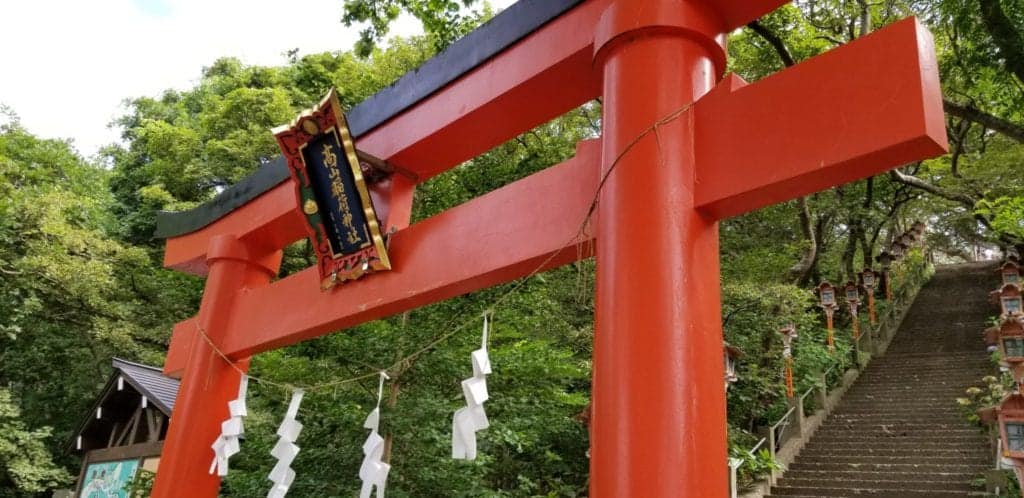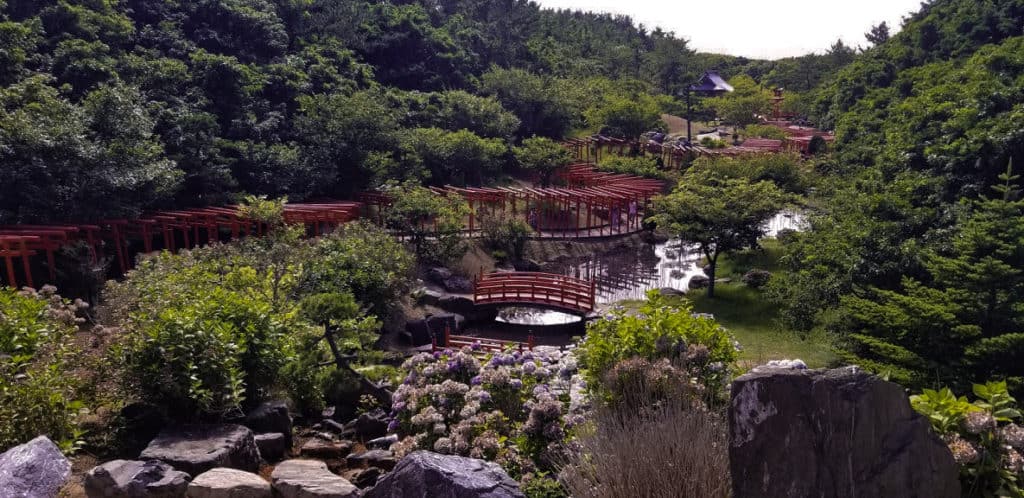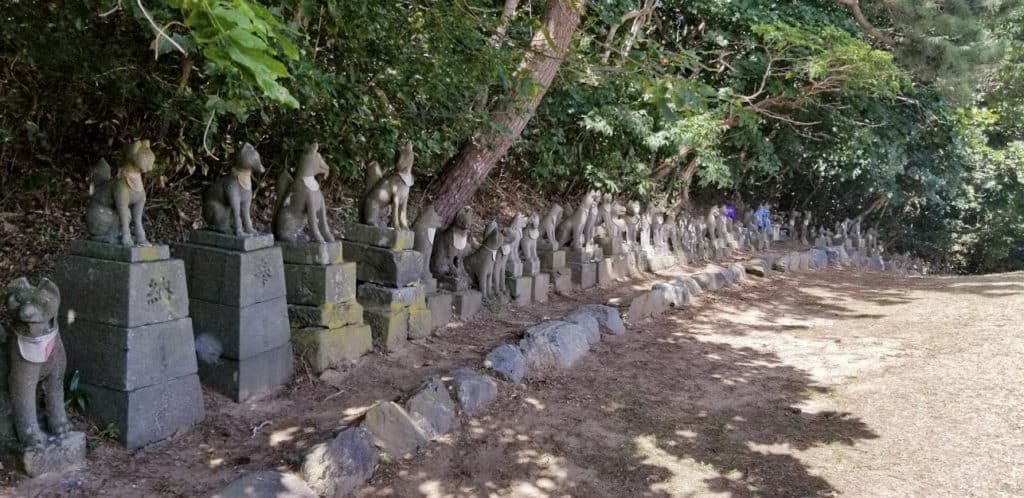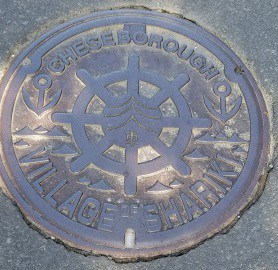Torii gate fan? I’m going to test your resolve. Getting to Takayama Inari Shrine (高山稲荷神社) in Tsugaru is not for the faint of heart even if you are like me and take crazy day trips! Seeing one of the most famous “thousand” torii gates in Japan is worth it though. And yes, there is a reason I put thousand torii gates in quotation marks! Keep reading.

[Editor’s Note: This post was originally published in August of 2018 and has been updated for freshness, accuracy, and comprehensiveness.]
Getting to Takayama Inari Shrine (高山稲荷神社)
First, I don’t suggest you do this trip like I ended up doing it. Amateur move, I didn’t realize at the time that there were no standing tickets on the Hayabusa Shinkansen except for a few at the end of the cars.
I showed up at Tokyo Station on a Friday evening to buy train tickets and there were none until the next day! That botched one hotel stay but gave the opportunity to check out some new izakaya around Tokyo station.
Thanks to a very jammed packed weekend plan for Aomori, that compressed the schedule for Takayama Inari Shrine greatly. But! Sometimes !@#$ happens on travel and you need to adjust.
It all worked out but in the future, I would suggest an early trek up to Aomori, with a full day in the capital (the capital of Aomori Prefecture is also named Aomori just to be confusing) and then starting what I’m about to tell you from that point.
Disclosure: Kristenabroad.com is a participant in the Amazon Services LLC Associates Program and other affiliate programs. For some links to products or services in this article, I may earn a small commission by you using my link. The price for you is not affected.
How to get from Tokyo to Takayama Inari Shrine
From Tokyo, you’ll want to take the 3.5-hour shinkansen ride to Shin-Aomori Station. From there, take the Ou Line towards Hirosaki and transfer at Kawabe Station to get up to Goshogawara Station. Luckily that is all on the JR lines so for you lucky enough to be able to use a JR Rail Pass, it’s covered! From there, it is a bus route or taxi.
This is PASMO dead zone, as I call it. Or it was when I went, not all rural stations or buses take IC Cards. None of these trains come very often so make sure to check your timetables and be aware of transfer times. The best option for these is Hyperdia. You will most likely be killing some time. Walk around, take some pictures, enjoy the weather!
The trains are fairly straight forward. Buses
How to get to Takayama Inari Shrine From Goshogawara
Once you’ve made it to Goshogawara Station, first, go straight to the bus station across the street, as seriously, the buses only come once every hour or two. Double
[Pro tip: When you are most likely waiting for the bus, go check out the Tachinebuta Museum, it’s amazing]
You’re looking for the 五所川原-小泊 route on the Konan Line, however, the boards are all COMPLETELY in Japanese, so get some practice in for your kanji numbers (the first character 五 or “go” is the number 5) or go talk to the nice station clerks.
The bus station attendees will be able to give you the time schedule (Click that link and look for 99 in the middle of the page, that’s your bus route!) and if you get the roundtrip ticket at the counter, you’ll save 300 yen.
The bus itself though, which luckily I noticed that none of the boards say that route name, will say 十三 経由 which is the last bit of information on the bus route. You’ll be getting off the 高山稲荷神社入口 (Entrance to Takayama Inari Shrine) stop after about a 40-minute bus ride.
Getting your exercise
From there, it’s about a 3.5 km walk (converting to English units that’s a little over 2 miles) or the bus station at the time had the number for the taxi stand. Follow the direction the bus was heading and it’s the first left and straight on from there till basically you run into the ocean.
Oh, and double-check the timetable for the return and remember it’s 30-45 minute walk back. Speaking of exercise, I love my Garmin Fenix 5S for keeping track of the insane amount of walking I do in Japan!

Numbers in Japanese that mean “many”
I’m going to digress for a second into a quick Japanese lesson. This is something it took me several years to learn (one failing on my love for the Minna no Nihongo series) and will help you understand different features around Japan. You’ll see why when I’m done.
There are actually several numbers in Japanese that often when they show up, are not numbers at all, but just another way to say “many”.
For instance the 99 Islands (九十九島, くじゅうくしま) between Sasebo and Hirado in Kyushu. There’s actually several hundred of them.
Another is 万. If you know your Japanese money, you’ll notice that’s the character that goes with the 一万 (ichiman, 10,000 yen, or about $100 USD) bill. If you ever see it on its own that is not what it means but “a myriad” instead. Also, it is no longer pronounced “man” but “yorozu”.
八百 (はっぴゃく, happyaku) is “800” but it too (for some reason, why are there so many??!!) can mean many. Like when you tack it in front of the word for “store” and magically it becomes “fruit and vegetable store” because you obviously have a lot of those but hardly 800!
That leads us to the use of 千 (sen, 1000), when talking about torii gates.

“Thousand” Torii Gates
Let’s talk a minute about the “thousand” torii gates (千本鳥居, senbon torii) at Takayama Inari Shrine. While the first word is, indeed, “thousand”, it normally gets directly translated as such. Just like Fushimi Inari Shrine in Kyoto. “The shrine with a thousand torii gates”.
In actuality, Fushimi Inari Shrine is estimated to have ten thousand torii gates. When you see 千本鳥居 it means “torii corridor” or just “many torii”. Same goes with Takayama Inari Shrine, the senbon torii that snakes like a dragon through the shrine is made up of a few hundred torii gates.
While I’ve often seen Takayama Inari Shrine referred to as “the Fushimi Inari of the North”, Takayama beats them out as far at the “Top 3″ Senbon torii in the country (remember I talked about another weird thing with numbers on my post about the 200 famous castles of Japan). Fushimi Inari is still one of the top Inari Shrines so you’ll be amazed by it as well and it should definitely be on your list when you visit Kyoto!
What that does say though is you should definitely make the ridiculous trip to Aomori just for this shrine! Oh, okay, and Hirosaki Castle and many other things as well!
Takayama Inari Shrine is beautiful
Is it worth it? The one other random foreigner that just by chance had the exact same start to his weekend itinerary to Aomori (seriously, weird chances – same shinkansen, same bus, same walk! But he missed out on the neputa museum) said he’d seen it as “one of the top 14 great shrines of Japan”.
Honestly, I can’t find anything that says that. But regardless, it’s beautiful and I’d say if you’re in for an adventure, make your way here. And see a bunch of Aomori while you’re at it.
The definite allure is the 200+ Torii gates you walk through as they snake their way through and make for a lovely walk. Watch out though, if you’re tall. I’m 175cm and it wasn’t that much higher than me.
How many torii gates are at Takayama Inari Shrine?
You’ll see 205, 208, around the internet, but technically there are many more than just the senbon torii around the property. Their website doesn’t actually give it to you stating it’s fun to count yourself! And don’t trust my voice in the video above, we were speculating and because I was trying to walk and not fall into the water, I wasn’t counting either!
Fox statues and small shrines
After walking through the string of torii gates and getting to the top, you may notice all of the fox statues and small house looking things of to the side.
Instead of komainu (狛犬) or lion-like dog guardians you see at other sects of Shinto shrines, the “inari” in Inari Shrine is the word for fox. Hence, the foxes were guardians at one point.
The small houses are actually shrines as well. They are called 祠 or hokora (and usually spelled in kana alone). They are little baby shrines normally found in the precincts of larger shrines but they are also found along roadsides. As such, I normally call them roadside shrines and they were there to keep people safe on the road.
Why are they here? I was joking it’s like their retirement home. Best I’ve been able to understand it is they are kind of like psalms in which once they’ve lived out their useful life, they are returned to the place of worship.

Staying at the Shrine
While I wasn’t able to do this myself, you have the option to stay at Takayama Inari Shrine! It’s a very reasonable 4000-7000 yen per night and you can have more time to enjoy the shrine and the views of the ocean. Did I mention the ocean is right there? You just need to contact them directly.
Lookout tower and memorial
Outside the main grounds of the shrine and back towards the main road, there is a turn off that will take you up the hill by the Otorii gate (Big Torii) to a lookout tower and give you a birds-eye view of the surrounding country and ocean!
At this location, there is also a memorial for the victims of the Cheseborough ship. A United States vessel that went down in 1889 off the coast. Only 4 of the crew were courageously saved by the locals and is commemorated here.

If you have been around for a while you know I love seeking out manhole covers, and they even had this one to commemorate as well! The Village of Shariki (車力村) was absorbed into Tsugaru with a bunch of other towns and villages.
Pin this for later

